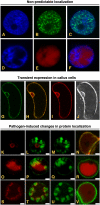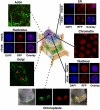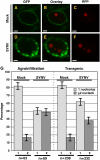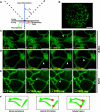New gateways to discovery
- PMID: 18056860
- PMCID: PMC2151732
- DOI: 10.1104/pp.107.106641
New gateways to discovery
Figures





Similar articles
-
Pumilio-based RNA in vivo imaging.Methods Mol Biol. 2015;1217:295-328. doi: 10.1007/978-1-4939-1523-1_20. Methods Mol Biol. 2015. PMID: 25287212
-
Very bright orange fluorescent plants: endoplasmic reticulum targeting of orange fluorescent proteins as visual reporters in transgenic plants.BMC Biotechnol. 2012 May 3;12:17. doi: 10.1186/1472-6750-12-17. BMC Biotechnol. 2012. PMID: 22554231 Free PMC article.
-
PSITE vectors for stable integration or transient expression of autofluorescent protein fusions in plants: probing Nicotiana benthamiana-virus interactions.Mol Plant Microbe Interact. 2007 Jul;20(7):740-50. doi: 10.1094/MPMI-20-7-0740. Mol Plant Microbe Interact. 2007. PMID: 17601162
-
In vivo RNA labeling using MS2.Methods Mol Biol. 2015;1217:329-41. doi: 10.1007/978-1-4939-1523-1_21. Methods Mol Biol. 2015. PMID: 25287213
-
GFP is the way to glow: bioimaging of the plant endomembrane system.J Microsc. 2004 May;214(Pt 2):138-58. doi: 10.1111/j.0022-2720.2004.01334.x. J Microsc. 2004. PMID: 15102062 Review.
Cited by
-
Distinctive interactions of the Arabidopsis homolog of the 30 kD subunit of the cleavage and polyadenylation specificity factor (AtCPSF30) with other polyadenylation factor subunits.BMC Cell Biol. 2009 Jul 2;10:51. doi: 10.1186/1471-2121-10-51. BMC Cell Biol. 2009. PMID: 19573236 Free PMC article.
-
Identification and Characterisation CRN Effectors in Phytophthora capsici Shows Modularity and Functional Diversity.PLoS One. 2013;8(3):e59517. doi: 10.1371/journal.pone.0059517. Epub 2013 Mar 25. PLoS One. 2013. PMID: 23536880 Free PMC article.
-
Advances in fluorescent protein-based imaging for the analysis of plant endomembranes.Plant Physiol. 2008 Aug;147(4):1469-81. doi: 10.1104/pp.108.120147. Plant Physiol. 2008. PMID: 18678739 Free PMC article. Review. No abstract available.
-
Evolutionary Analysis of Snf1-Related Protein Kinase2 (SnRK2) and Calcium Sensor (SCS) Gene Lineages, and Dimerization of Rice Homologs, Suggest Deep Biochemical Conservation across Angiosperms.Front Plant Sci. 2017 Apr 5;8:395. doi: 10.3389/fpls.2017.00395. eCollection 2017. Front Plant Sci. 2017. PMID: 28424709 Free PMC article.
-
Identification and functional assay of the interaction motifs in the partner protein OsNAR2.1 of the two-component system for high-affinity nitrate transport.New Phytol. 2014 Oct;204(1):74-80. doi: 10.1111/nph.12986. Epub 2014 Aug 7. New Phytol. 2014. PMID: 25103875 Free PMC article.
References
-
- Alonso JM, Stepanova AN, Leisse TJ, Kim CJ, Chen H, Shinn P, Stevenson DK, Zimmerman J, Barajas P, Cheuk R, et al (2003) Genome-wide insertional mutagenesis of Arabidopsis thaliana. Science 301 653–657 - PubMed
-
- Bates IR, Wiseman PW, Hanrahan JW (2006) Investigating membrane protein dynamics in living cells. Biochem Cell Biol 84 825–831 - PubMed
-
- Brandizzi F, Irons SL, Johansen J, Kotzer A, Neumann U (2004) GFP is the way to glow: bioimaging of the plant endomembrane system. J Microsc 214 138–158 - PubMed
-
- Brasch MA, Hartley JL, Vidal M (2004) ORFeome cloning and systems biology: standardized mass production of the parts from the parts-list. Genome Res 14 2001–2009 - PubMed
Publication types
MeSH terms
Substances
LinkOut - more resources
Full Text Sources

